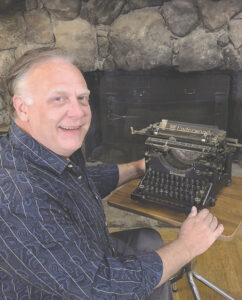The Old Flagpole, Gone to Pieces
The first six lots of the Little Lands Colony were sold on March 17, 1913. The Little Landers declared they would restore to the American people their lost inheritance of individual independence and lift the standard of living higher than ever before. A tall order indeed, but this utopian-minded group set out to prove that hundreds of people, living on small lots with intensive cultivation not only of soil but also of social, intellectual and spiritual life, could create a fine existence for themselves. This colony would become Tujunga.
Early business for the colonists was the construction of a stone clubhouse. It would serve as the setting for meetings, church services, weddings and all other social events of the day. Over 200 persons – men, women, and children – were present for the laying of the cornerstone in April of that year. Completed in record speed, the building was dedicated on Aug. 22, 1913, and the future looked bright for these new colonists.
Soon a small, excited group was on hand just outside the clubhouse as workers began the process of raising the community’s first flagpole. A single beam of wood, 40 feet in length, was laid before them. The thick base was seven inches square and tapered to 3.5 inches at its top. The bottom section was square for 13 feet then became octagonal in shape for the next 17 feet until becoming circular for about the last 10 feet.
The old flagpole held the red, white and blue high and proud through many years and events. The clubhouse became the American Legion Hall (1921), which became Tujunga City Hall (1925), then a Los Angeles municipal facility (1932) and finally Bolton Hall Museum and home to the Little Landers Historical Society (1981). In 2005, the grounds surrounding the stone hall were being renovated with the intention of restoring the 91-year-old flagpole. After careful inspection it was determined to be beyond repair and scheduled to come down. A new 45-foot flagpole was crafted and dedicated on Dec. 4, 2009.
What became of the ancient wooden beam after retirement? Initially it was cut into numerous large pieces and stored away in a horse barn in Sunland; all but the top four feet, which was put on display in the southwest corner of the museum. There it still has the original pulley that hoisted Old Glory so many times before. Today, an American flag with 48 stars, as was flown in the early days of the Little Landers, accompanies this top section. The remaining round length of the pole was then chopped into many pieces. One of these can be found as the stand for the stereoscope on display. Another is the doorstop to the gift shop adorned with a sign that reads, “The Door Stops Here.” Then a whole slew of 1¼-inch slices were cut, eliminating the upper, round section. These slices were then varnished and turned into awards given to supporters of the historical society. Some included a metal plaque reading, “Piece of the Original 1914 Bolton Hall Flagpole.”
The last sections of the flagpole sat undisturbed until I learned of their existence in 2020. I had just become involved with the Verdugo Hills Cemetery and had an idea. I asked for the remaining pieces to benefit the cemetery and received them. The uppermost section was then cut into 1½ inch slices. These were then distributed to dozens of creative individuals who turned them into amazing pieces of art. They were auctioned at the centennial celebration in 2022, raising thousands of dollars for the care and maintenance of VHC. With the remaining pieces in my possession, the old flagpole has been accounted for except for some of the very bottom. That may still be in the back of the dusty horse barn.

